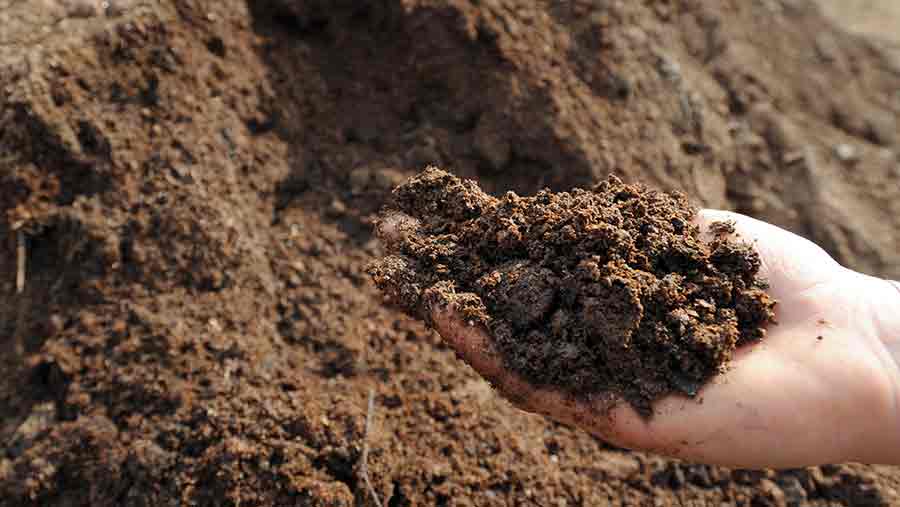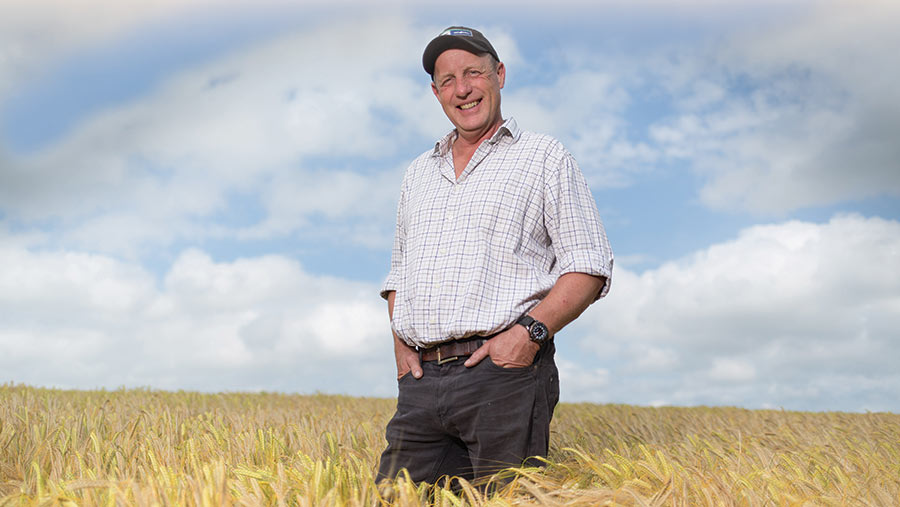How to achieve the perfect soil composition
 ©KPA/Zuma/Rex Shutterstock
©KPA/Zuma/Rex Shutterstock Keeping a close eye on the level of organic matter in soils and having a long-term strategy to build it up will prove critical in sustaining future crop yields and the performance of arable land.
Organic matter is made up of undecomposed plant, animal and micro-organism residues and humus, formed over many years.
It influences the physical, chemical and biological properties of the soil, improving its structure, water-holding capacity, fertility and the action of pesticides.
However, this valuable substance has been in decline for many years as land is more intensively cultivated, says Tim Bevan, farm business manager at the Soil Association.
See also: Cracking soil compaction will raise crop yields
Cultivation, in particular ploughing, destroys organic matter as it oxidises when exposed to the air.
How to increase organic matter in your soils
- Reduced or min-till cultivation Less stirring and mixing of soil minimises oxidation and loss of organic matter
- Crop residues Ploughing straw back into the land can provide important supplies of organic matter
- Green manure or cover crops These are then ploughed into the soil
- Including leys or pasture within a crop rotation A highly effective way to build up organic and restore soil structure and health
- Sewage sludge or animal manure applications Check that they do not contain excessive amounts of heavy metals, which would contaminate soils
“Today we don’t really know how bad the situation is in terms of organic matter loss because only very limited testing has been conducted. What we do know is that organic matter and soil fertility are inherently linked,” he says.
Last year, researchers at the University of Sheffield warned there could only be 100 harvests left in British farmland as intensive farming was harming soil health.
Long-term view
Yara agronomist Ian Matts tells Farmers Weekly that increasing organic matter is a tough long-term challenge for growers on all soil types, but must be faced.
“Soils are an asset and organic matter is absolutely vital for growers who want to achieve the greatest return. In a year when wheat prices are falling below the cost of production, this is something that all growers will want to aim for.”
Major benefits lie in the moisture dynamics, so the soil can hold on to water in a drought or move water through the soil profile quicker in a wet year, explains Mr Matts.
“Organic matter plays a pivotal role in improving the soil structure of heavy land by reducing compaction. On light land it gives more body to help with wind and water erosion.
“It also gives more binding sites and allows phosphate and nitrogen to be released and accessed more readily.”
The loss of organic matter causes the soil to lose its crumb-like texture, making it more liable to slumping. Mr Bevan points out that this will lead to a greater risk of compaction and waterlogging.
“You cannot have good soil structure without high levels of organic matter and we all know the impact that poor soil structure can have on crops,” he says.
Testing
More farmers are monitoring their soil organic matter levels, as demonstrated by a 10% jump in demand for testing since 2013. Perhaps unsurprisingly, there has also been an escalation in soil samples found to be deficient in organic matter.
Mr Matts speculates that this spike in interest could have been sparked by the miserable harvest in 2012, where lasting damage was inflicted on soil health and structure.
The best way to test soil is by sending samples to a laboratory, rather than digging a pit and using a colour chart. He points out that testing for organic matter content will typically add £7 to your average soil test bill, making it worthwhile when going to the trouble to take the sample in the first place.
He says that 3.5% is a good target for most growers, but acknowledges that the ability to achieve this depends on soil type.
Few growers measure the percentage of organic matter in their soils because it is unlikely to change significantly from year to year.
However gaining a baseline measurement enables farmers to track whether it is increasing over time and where it varies across the farm. Then monitor by testing every four to five years, as increasing organic matter will take patience and persistence, he says.
| Scoring your soil | |
| % organic matter | Score |
| <1 | Very low |
| <2 | Low |
| <4 | Medium |
| <8 | High |
| >8 | Very high |
| >30 | Peat soil |
“The number you get from your first test won’t be as important as subsequent test results – it is simply a number to increase. It is very much a long-term process and it can be difficult to see the benefits.”
He warns that even if initial testing reveals a good organic matter amount, it is still necessary to add to existing levels.
“It is far easier to lose organic matter than it is to build it up, so you don’t want to take your eye off the ball and slip into a fire-fighting situation.”
Soil type
One of the biggest influences on organic matter levels and the ease of increasing it is soil type. Sandy soil has inherently low organic matter, while peaty soils have naturally high levels.
Clay and loamy soils lie somewhere in between, depending on individual composition, use and management.
Grassland will often have higher organic matter levels than arable land with the same soil type because of expansive root systems.
Mr Matts explains that light soils are most important to increase organic matter because their natural ability to retain water is low, making them highly vulnerable to drought.
Organic matter contains about 95% of a soil’s nitrogen, 90% of its sulphur and normally 30-50% of the phosphorus content.
“The greater the amount of organic matter in the soil, the greater the number of nutrients that the soil can hold and so the greater its potential productivity,” he explains.
Aside from possible yield hikes, there are also financial advantages to be had, says Mr Bevan. “In some cases it can give you an uplift in yields, but research shows that you can get away with applying less nitrogen while maintaining yields, so there is a potential cost saving benefit as well.”
Increasing levels
Of the many ways to increase organic matter, Mr Bevan says putting a field into a grass or clover ley will yield the best results but recognises this won’t be appealing to all growers.
“If you want to raise organic matter the quickest way to do so is to put a field down to grass, but green manures or straw-based livestock muck will also build organic matter quickly.”
He adds that while slurry will have a positive effect on organic matter, livestock manure with high straw content will tend to give better results.
Having a mixed crop of fast-growing green manures with a range of rooting depths is also very effective, helping with compaction on top of the benefits to organic matter.
These can then be sprayed off with glyphosate or cultivated into the soil but Mr Bevan admits that ploughing in green manures will inevitably burn off some of the organic matter.
Case study: Wheatsheaf Farming Company, Hampshire
It was Hampshire grower David Miller’s determination to improve soil health that saw him crowned Farmers Weekly’s 2015 Arable Farmer of the Year.
In the past two years Mr Miller (pictured below) and his team have been making real efforts to increase organic matter content, mainly using straw and green manures.
The farm moved over to a no-till system to avoid burning off organic matter, replacing machinery cultivations with cover crop roots.
Organic matter levels across the farm range from 5-7%, although these figures were obtained using the loss on ignition method, which can overestimate figures on certain soil types.
These readings are used as a benchmark for improvements.
To understand how healthy soils with good levels of organic matter would benefit him, Mr Miller conducted his own cover crop trials with a bean and vetch autumn cover crop and drilled spring barley into it.
Noticeable yield benefits continued to be seen in the following crop,
18 months after ploughing in the cover crop.
“We came to the conclusion about five years ago that the soil was the limiting factor on yields and we needed to improve our soils. Organic matter is just one part of that, but it is a fundamental piece of the jigsaw,” he says.
“You have to look at it in five-year blocks. In the first five years there might not be any scientifically measurable benefit, the next five will hopefully see measurable improvements and 15 years down the road we may start to see benefits like being able to reduce fertiliser inputs and saving money.”
As farm manager at Wheatsheaf Farming Company, Mr Miller oversees 1,600ha across six farms which sit mostly on light flints over chalk.
Cropping consists of winter wheat, oilseed rape, winter and spring barley, spring oats, yellow linseed and cover crops.


